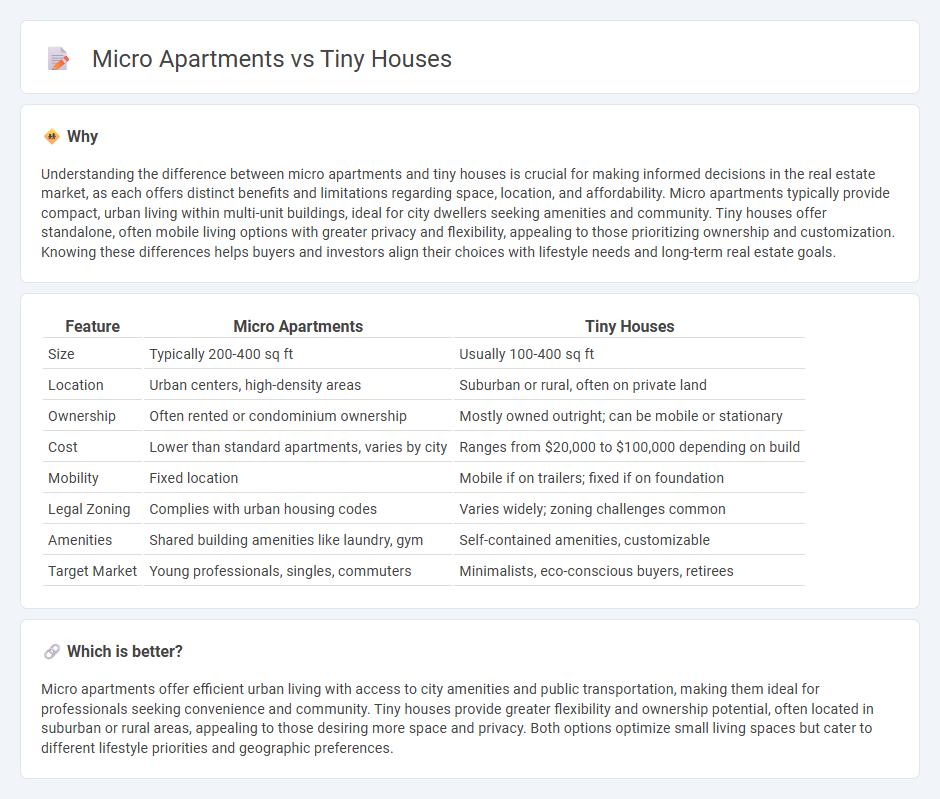
Micro apartments maximize urban living with efficient layouts typically below 350 square feet, ideal for professionals seeking affordability and proximity to city centers. Tiny houses, usually ranging from 100 to 400 square feet, offer ownership flexibility and mobility, appealing to those prioritizing minimalist lifestyles and sustainable living. Discover which compact living solution fits your needs and lifestyle preferences.
Why it is important
Understanding the difference between micro apartments and tiny houses is crucial for making informed decisions in the real estate market, as each offers distinct benefits and limitations regarding space, location, and affordability. Micro apartments typically provide compact, urban living within multi-unit buildings, ideal for city dwellers seeking amenities and community. Tiny houses offer standalone, often mobile living options with greater privacy and flexibility, appealing to those prioritizing ownership and customization. Knowing these differences helps buyers and investors align their choices with lifestyle needs and long-term real estate goals.
Comparison Table
| Feature | Micro Apartments | Tiny Houses |
|---|---|---|
| Size | Typically 200-400 sq ft | Usually 100-400 sq ft |
| Location | Urban centers, high-density areas | Suburban or rural, often on private land |
| Ownership | Often rented or condominium ownership | Mostly owned outright; can be mobile or stationary |
| Cost | Lower than standard apartments, varies by city | Ranges from $20,000 to $100,000 depending on build |
| Mobility | Fixed location | Mobile if on trailers; fixed if on foundation |
| Legal Zoning | Complies with urban housing codes | Varies widely; zoning challenges common |
| Amenities | Shared building amenities like laundry, gym | Self-contained amenities, customizable |
| Target Market | Young professionals, singles, commuters | Minimalists, eco-conscious buyers, retirees |
Which is better?
Micro apartments offer efficient urban living with access to city amenities and public transportation, making them ideal for professionals seeking convenience and community. Tiny houses provide greater flexibility and ownership potential, often located in suburban or rural areas, appealing to those desiring more space and privacy. Both options optimize small living spaces but cater to different lifestyle priorities and geographic preferences.
Connection
Micro apartments and tiny houses both offer compact, efficient living spaces designed to maximize utility within minimal square footage, catering to urban dwellers and minimalist lifestyles. These housing solutions address rising real estate costs and limited land availability by providing affordable and sustainable alternatives to traditional homes. Developers leverage innovative design and multifunctional furniture to optimize small footprints, meeting growing demand for flexible, low-maintenance residential options.
Key Terms
Square Footage
Tiny houses typically range from 100 to 400 square feet, providing compact yet fully functional living spaces often with separate rooms and outdoor areas. Micro apartments usually measure between 200 and 350 square feet, maximizing urban living through efficient layouts and shared amenities. Discover more about how square footage impacts lifestyle choices in tiny houses and micro apartments.
Zoning Regulations
Zoning regulations for tiny houses often vary by locality, with many areas requiring tiny homes to be classified as accessory dwelling units (ADUs) or placed in specific zones to ensure compliance with building codes. Micro apartments face distinct zoning challenges, typically found in urban zones with multi-family residential designations, where minimum unit size and occupancy standards impact their development. Explore detailed zoning requirements to understand how each housing type fits into urban planning frameworks and legal constraints.
Affordability
Tiny houses typically range from 100 to 400 square feet, offering affordable private living spaces with lower utility costs compared to micro apartments, which average around 200 to 300 square feet in densely populated urban areas. Micro apartments provide affordability through shared amenities and prime city locations, often resulting in higher rent per square foot but lower overall monthly expenses. Explore more about the cost benefits and lifestyle trade-offs between tiny houses and micro apartments.
Source and External Links
Tiny-house movement - Wikipedia - The tiny-house movement promotes reducing living space, usually under 400-600 sq ft, offering lower-cost and eco-friendly housing options, though legal and practical challenges exist for owners.
84 Tiny Homes That'll Convince You to Downsize ASAP - Country Living - Stylish tiny homes under 1000 sq ft showcase innovative design and clever space-saving ideas, ranging from restored cottages to converted boathouses.
Father Builds Ultra-Affordable Tiny Home for Himself and His Daughter - YouTube - A father builds a sustainable, off-grid tiny house for about US$23,000 using salvaged materials and solar passive design, exemplifying affordability and eco-consciousness in tiny living.
 dowidth.com
dowidth.com